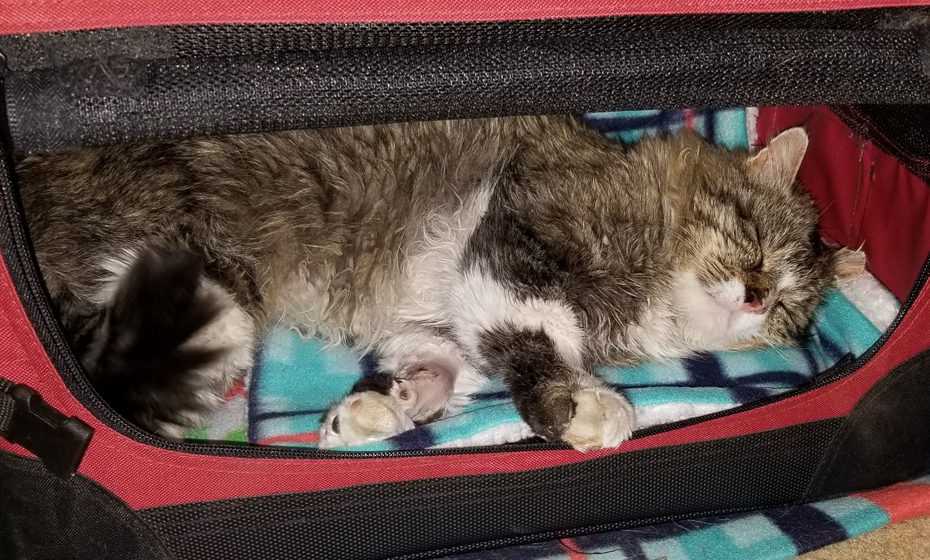Dear Ms. Kitty,
This year, I’m resolving to take my cats to their veterinarian for their yearly checkups, even though they get so scared it breaks my heart to do so. Is there anything I can do to make it easier on them and me?
You’re not alone being stressed on Vet Day! Research says that 38% of cat guardians get stressed just thinking about it and over 20% of vets don’t even examine their own cats yearly.
The biggest obstacle is getting your cat there. The second we get out the carrier—aka the Transportable Torture Device—our cats usually vanish. It’s no wonder we are stressed too by the time we actually get to the vet.
At Happy Cats Haven, we work with the most stressed cats, those who have lost everything they knew and loved.
We have to transport cats too, with veterinarian visits as well as getting them home to their new families. Here are 12 tips we use to make Vet Day as stress-free as possible.

CAT FRIENDLY VETS
Sadly, research shows that far fewer vets prefer working with cats than dogs, 17% vs 48% in one study. Dogs tend to get less stressed at the vet and that translates into less stress for the vet.
The days of stressing cats by ignoring their terrifies but subtle body language may be waning. Many practices are now certified in Fear Free Handling. Some vets are also certified to be Cat Friendly Practices.
These clinics have taken the time to learn how to minimize your cat’s stress. A cat who is less stressed will be easier to examine and easier to treat.
If your vet has a busy, noisy, multi-animal practice, consider letting them know you have arrived and wait in the car for them to get you. There’s no sense terrifying your cat before you even get inside.
START EARLY
Once you have your vet visit arranged, get out that carrier. Ideally, do this at least a month in advance. Put the carrier in a corner of a room where you hang out with your cats. The goal is to make it just another piece of your furnishings.
CHECK YOUR CARRIER
The most heartbreaking stories are ones where the cat was put in the carrier only to have it break open when picked up, dumping the cat out to run away, terrified. Many of these cats are never seen again, especially if it breaks open in a strange place.
It’s easy to lose the small parts of carriers. Check your carrier for missing pieces and make sure all fasteners are working properly. If anything is suspect, use a bungee or two to wrap around the carrier or make sure to secure any missing parts with zip ties.

CARRIER CAMO
Cats in stress search out small, dark places to sooth themselves. Change the carrier from being a torture device to being a place your cat wants to be.
Take an old pillow case or piece of fabric and drape it over the carrier from side to side, covering the holes. Slit it the short way so you can reach the handle. Also place some of your cats’ favorite bedding in the carrier to help normalize it as just another place to sleep.
REWARD, REWARD, REWARD
Every day, place some of your cats’ favorite treats in the carrier and make sure they know they’re there. Allow them to find the treats on their own and eat at their leisure.
If you do this daily, you’ll soon have a cat who is having a good experience in the carrier. You may even find they are choosing to go in the carrier on their own, or even to nap there. It’s always helpful when cats choose to do what you wanted them to do all along!
FOR COWARDLY LIONS
Please don’t use a soft sided carrier if your cat is shy. You’ll need to close the carrier quickly once you get your cat in it and soft carriers are harder to close. A hard sided carrier is much easier to lure a cat into and close quickly. 
TREATS BEFORE SURGERY
If you have to remove your cats’ food for surgery, try some fish flake treats (Cat Man Doo is one brand, or buy at an Asian market). They appeal to most cats but will not compromise their food ban. Another option is to offer just the gravy from canned food, no more than 1/4 teaspoon.
LIE IN WAIT
The night before Vet Day, make sure your cats’ food runs out, especially if you free feed. If you schedule feed, feed them a little less than you normally would. A little hunger can be a great motivator.
On Vet Day, get out your cats’ most favorite treats. Toss them into the very back of the carrier. If they are crunchy, try to hit the carrier wall so the cat hears them.
Stand close (but nonchalantly!) by the carrier. The second the cat is at least 2/3 inside, move purposefully and quickly to shut the door, using the door to push the cat all the way inside. Do not shut the door on the cat’s tail! Quickly lock the door so the cat cannot escape.

LAST RESORT
If you can’t get your cats to go in the carrier on their own, DO NOT CHASE THEM DOWN. Get out their breakfast (they haven’t eaten since last night, right?) and take it into a small room, like a bathroom.
Don’t use a bedroom as they will hide under the bed. If they haven’t eaten since the night before, they should be interested.
Let them eat a little and then bring in the carrier, keeping them in the room. Try not to rattle any metal parts to scare them unnecessarily. Tip the carrier on end with the opening at the top.
Pick up your cat and put him or her down in the carrier tail down. You will have to drop the cat a few inches to get in, but that shouldn’t hurt.
Research shows scruffing can be detrimental to cats, but this is one case where a swift scruff to quickly put the cat in the carrier may be justified to help immobilize him or her with the least trauma.
CALMING PRODUCTS
A product called Feliway is an artificial cat pheromone. It can be helpful in soothing your cat for transport. Spray some Feliway on the covering and allow to dry for 10 minutes before re-covering.
Another product called Calm-o-mile is a veterinarian-made essential oil blend that works very well for cats. Adding a small cloth with a drop of oil on it may also help calm your kitty.
LEVEL IT OUT
Either carry the carrier from the bottom or be very careful to keep it level when carrying by the handle. Swinging your cats around when you move them only adds to their stress.
SOOTHE THEIR RIDE
Play soft music in the car, like classical or light music. If the cat cries, speak occasionally in soft tones but try not to encourage meowing.

A NOTE ON CARRIERS
Some people prefer carriers that open from the top so the cat can be placed inside that way. Some prefer carriers where the top can be removed, as they allow the vet to examine the cat in place without having to drag them out of the carrier, especially if they can stay partially covered with familiar bedding to soothe them. Some prefer soft sided carriers because they are lighter.
Whatever your choice of carrier, make sure the clasps or zippers are sturdy and cat-proof, so it doesn’t break open to let your cat fall out to be lost. Also, make sure your carrier is big enough and not collapsed to allow room for your cat to turn around and lie comfortably .

PLEASE NOTE: We do NOT recommend so-called “carriers” that are bags designed to trap cats with their heads out. Most cats are well-researched to be less stressed when they can hide. These products do the complete opposite: they immobilize cats while forcing them to be flooded with the sights, sounds and smells that most cats are afraid of. Imagine yourself in a straight jacket, then being forced into one of your scariest situations. This is what these products do to most cats.
Once you get to your vet, these unfortunate products continue to get in the way of a proper examination as well as not providing stress relief. Please do your cats a favor and purchase a carrier that allows your cats to do what they would normally do when scared: find a safe place to hide.
With a little planning, everyone can be less stressed on Vet Day: you, your cat and your vet included!
Sara Ferguson is the Director of Happy Cats Haven.




